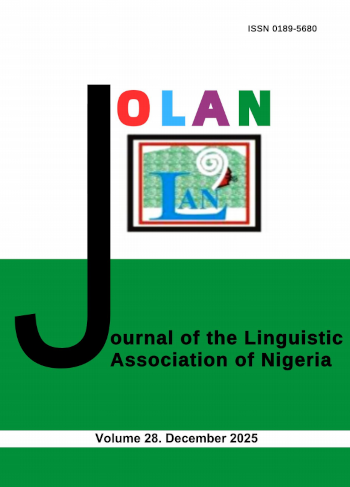An Autosegmental Analysis of Berom Tones and Tonal Processes
Keywords:
Berom, Autosegmental phonology, tone, tonal copying, tonal replacementAbstract
Tone is notorious for its independence from the segments on which it is realized (Yip 2002). This paper adopts a descriptive approach to the study of Berom tones and tonal processes alongside the application of the autosegmental phonology framework in examining how these phenomena operate in Berom. Berom is a language spoken in Northern Plateau with speakers occupying four local government areas namely- Jos South, Jos North, Barkin Ladi and Riyom; but the data obtained for this study is based on the dialect spoken in Riyom. Tones play a very significant role in Berom. Tones have the tendency to influence segments, syllables, morphemes and even words in Berom. Berom exploits three (3) distinctive register tones- High [ˊ], mid [ˉ ], low [ ˋ ] and two contour tones: rising [ ˇ ] and falling [ ̂ ] tones; both of which perform lexical and grammatical functions. This paper adopts the autosegmental framework in its analysis with the view to clearly illustrate how Berom tones function and highlight two (2) tonal processes in Berom- tone copying and tonal replacement. This paper finds out that in tone copying, the plural prefix ‘be-’ is underlyingly toneless; therefore, it copies the tone of the root it is attached to in its derivation (whether it is high or low). Whereas in tonal replacement, a high tonal morpheme [ ˊ ] replaces the tone(s) of root from which they are derived. More so, tonal replacement in Berom is applicable to some irregular plural formations and the derivation of the progressive aspect of Berom verbs.
References
Abiodun, M. (2007). “Phonology”. In Ore Yusuf (Ed.). Basic linguistics for Nigerian languages teachers. Port Harcourt: M & J Grand Orbit Communications Ltd. Pp. 51-78.
Amfani, H. (2007). “Hausa phonology”. In Ore Yusuf (Ed.). Basic Linguistics for Nigerian languages teachers. Port Harcourt: M & J Grand Orbit Communications Ltd. Pp. 131-137.
Anyanwu, R. J. (2008). Fundamentals of phonetics, phonology and tonology. Germany: Deutsche National Biliothek.
Blench, R. & Dendo, M. (2006). The Tahoss dialect of the Berom language of Central Nigeria and its affinities. http://www.rogerblench.info/RBOP.htm.
Bouquianx, L. (1970). Texts Birom (Nigeria Septentrional) avec traduction et commentaires. Paris: Docteur en philosophie et
letters licencié en histoire et literatures orientales.
Chollom, E. J (2004). A sematic analysis of Berom personal names. An unpublished B.A project. University of Jos.
Dienes, P. (2000). VC phonology: a theory of consonant lenition and phonotactics: M.A Thesis. Eöthvös Loránd Univer
Emenanjo, N. E. (2015). A grammar of contemporary Igbo: constituents, features and processes. Port Harcourt: M & J Grand Orbit Communications Ltd.
Goldsmith, J.A. (1976). Autosegmental phonology. Ph.D dissertation, MIT. New York: Garland Press.
______________ (1990). Auto segmental and metrical phonology. Oxford: Basil Blackwell Ltd.
Green, M.M. & Igwe, G.E. (1963). A descriptive grammar of Igbo. Oxford University Press.
Gwom, S.L. (1992). The Berom tribe of Plateau state of Nigeria. Jos: Fab Educational Books.
Ikekeonwu, C. (1996). Introduction to elements of phonology.” In O.S Ogwueleka et al. (eds.) Effective English usage. Lagos: Green Publishers.
____________ (2008). “Issues in Igbo phonology.” In I. Ikwubuzo, C. Ohiri-Aniche & C. Nnabuihe (eds.). Udezuluigbo: A Festschrift in honour of Sam Uzochukwu. Lagos: Green Olive Publishers.
Nyam, S.D. (2005). Berom socio-cultural festivals and Ceremonies: from the pre-colonial times to date. Jos: BH Publica
Obasi, G. T. & Ayegba, M. (2011). Autosegmental phonology. An unpublished seminar presented to the Department of Linguistics, Igbo and other Nigerian Languages for the award of M.A (Linguistics)
Omachonu, G.S. (2011). “Phonetics and Phonology.” In G.S. Omachonu (ed.) NSUK Texts in General Linguistics. Vol. 1. Enugu: Rossen Publications Ltd.
Oyebade, F.O. (1992). ‘Phonology II’. In Ore Yusuf (ed.). Introduction to linguistics. Ilorin: University of Ilorin Press.
____________ (1998). A course in phonology. Ilorin: Shebiotimo Publications.
Piyo, E.V. (2007). The tone system of Berom. An unpublished B.A project. University of Jos.
Williamson, K. & Blench, R. (2000). Niger-Congo: In Bernd Heine & Derek Nurse (eds.). African languages: an introduction. Cambridge: Cambridge University Press. Pp 11-42.
Yip, M. (2002). Tone. Cambridge: Cambridge University Press.
Yul-Ifode, S. (1999). A course in phonology. Port Harcourt: Riverside Communications.














